 |

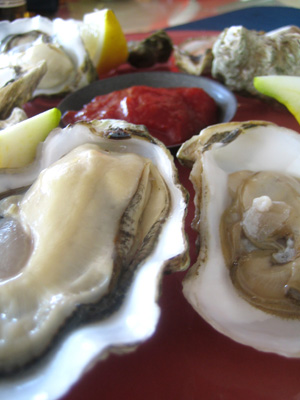 |
| Oyster heaven. At left, the large Pacific oyster; to the right, the medium-size Virginica oyster. Photo by Melody Lan. |
| WHAT IT IS: The freshest live Kumamoto, Pacific and Virginica oysters sold by the dozen, overnighted from Washington. |
| WHY IT’S DIFFERENT: Grown in oyster beds in the cleanest estuary in the U.S., the purity of the environment and the direct-to-you freshness let the oysters’ true flavors shine through. |
| WHY WE LOVE IT: Hedonism without guilt, luxury without sticker shock. After all the great chocolates, wonderful caviars, plates of foie gras, exquisite cakes and pastries—not to mention the fabulous restaurant meals—we enjoy each week, the greatest “wow” we can recall is sitting down to three dozen fresh, pure, meaty oysters from Willapa Oysters. |
| PURCHASE AT: Willapa-Oysters.com. |
|
|
 |

Willapa Oysters: Happiness On The Half Shell
CAPSULE REPORT: It isn’t often that one of our Top Picks Of The Week is also a low-calorie, high-protein marvel. After all, our job is to find the best-tasting food, not the healthiest. When we find one that fits into both buckets, it is double happiness.
Such is the case with Willapa Oysters. We eat oysters on the half shell at least once a week, but now we realize that we had never really tasted an fine oyster until our shipment from Willapa Oysters arrived. They’re grown in beds in the cleanest estuary in America. They’re picked and overnighted to you the same day, avoiding the distribution chain, where they sit and fade. With Willapa, you eat an oyster that’s not only pristine from its surroundings, but as fresh as can be without a visit to the ocean. With shipping, the cost is what you’d pay at a restaurant, but the oysters are so much better. It’s an experience you won’t believe...and an indulgence you won’t want to give up, ever. Read the full review below.
- For more of our favorite seafood items, click here.
- For the table of contents of the May issue of THE NIBBLE online magazine, plus the back issues archive and our most popular articles, click here.
- All of the weekly newsletters are permanently archived on TheNibble.com.
|
THE NIBBLE does not sell the food products we review or receive fees for recommending them.
Our recommendations are based purely on our opinion, after tasting thousands of products each year, that they represent the best in their categories. |
Oyster-Lover’s Reading List
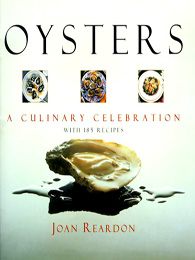 |
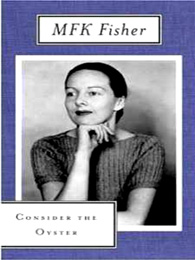 |
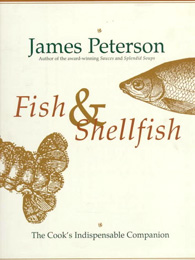 |
Oysters: A Culinary Celebration,
by Joan Reardon. With 185 creative recipes from classic Oysters Rockefeller to special occasion Oyster Beignets to Oysters Benedict for Sunday brunch, this book is also a marvelous reference for preparing oysters. Plus, there’s every elusive oyster fact and helpful hint. Click here for more information. |
Consider the Oyster, by M.F.K. Fisher. One of the greatest food writers of all time focuses her attention on the oyster. Said Clifton Fadiman, “Since Lewis Carroll no one had written charmingly about that indecisively sexed bivalve until Mrs. Fisher came along....Surely this will stand for some time as the most judicious treatment in English.” Click here for more information. |
Fish & Shellfish: The Definitive Cook’s Companion, by James Peterson. A comprehensive, organized guide to cooking seafood. More than 150 recipes from the classic to the innovative. Step-by-step photographs and notes include necessary equipment plus the author’s own experiences. An outstanding cookbook. Click here for more information. |
Happiness on the Half Shell: Willapa Oysters
Little did we know that some preliminary research for an article on St. Patrick’s Day comestibles would bring us one of the most memorable days of our gustatory life. We had no idea that oysters were a prominent food in Eire—we were seeking classics like soda bread, steel-cut oatmeal, smoked salmon, ale and stout. But when oysters turned up on a short list of Irish delicacies, we set off to find the best oysters in the land (this land, not the Old Country). That search produced one of the most wonderful feasts of the year—and we say this with certitude, even though it’s only May.*
*What happened to St. Patrick’s Day? We won’t say that our ardor over these oysters single-handedly depleted the entire supply, but the beds did need to be replenished and the proprietor asked us to hold our story for a few weeks.
For decades, we have regularly enjoyed a dozen on the half shell everywhere from the most expensive seafood restaurants to beachside clam and oyster shacks. Our Willapa Oysters were a 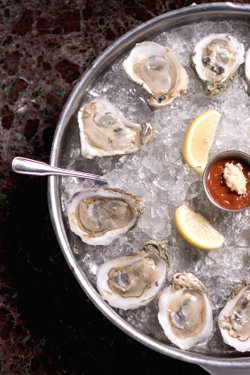 revelation: we ended our initial experience knowing that we had never had anything as good as the pristine, absolutely fresh oysters that arrived at our doorstep, picked from beds in Willapa Bay, Washington. Even as a fervent foodie, if it weren’t for our job—which is to discover fabulous foods—we’re not sure we would have ordered oysters by mail. We live in a seaport and there’s a great fish market five blocks away. revelation: we ended our initial experience knowing that we had never had anything as good as the pristine, absolutely fresh oysters that arrived at our doorstep, picked from beds in Willapa Bay, Washington. Even as a fervent foodie, if it weren’t for our job—which is to discover fabulous foods—we’re not sure we would have ordered oysters by mail. We live in a seaport and there’s a great fish market five blocks away.
But our eyes were opened; our taste buds were born again. And we learned that even restaurants in a seaport can serve oysters that have been in coolers for two weeks; which is why many oyster-lovers have never had an Amazing Oyster Experience. The good news is, depending on what time of day you are reading this, you can become “experienced” tomorrow or at most, two days from now.
Willapa Oysters come from...Oysterville. You can see it on the map below as the topmost yellow dot on the Long Beach peninsula (home to the world’s longest beach). If you have really good eyes, you can read the word Oysterville in the white type that extends perpendicularly into Willapa Bay†. If you close your eyes, you can see the little town as it was 100 years ago: most of the buildings date to then, and walking through town is like walking back through time.
†There are a half dozen other towns on the peninsula; but for the sake of being able to point out Oysterville, we Photoshopped them out (with all due respect).
Willapa Oysters is run by John Rowell, a third-generation fisherman. His grandfather, Douglas Rowell, began a salmon fishing and oystering business nearby. The family had a salmon cannery; but for many decades, the pleasure of sitting down to dozens of freshly opened oysters was a local one. Today, with online ordering and overnight shipping, the pleasure can be enjoyed by anyone fortunate enough to learn about Willapa Oysters.
Clean Water Makes Great Oysters
|
Willapa Bay has the highest water quality and is the cleanest estuary in the continental United States. Clean, cold Pacific Ocean water grows absolutely pure shellfish (the water throughout the year hovers between 40°F and 68°F). Willapa Bay is about 125 miles southwest, or a three-hour drive, from Olympia, the state capital; it’s another hour northeast to Seattle. There’s not much around: there are some small towns on the peninsula and in the environs, but that huge green area on the continent encircled by the highway is the Willapa Wildlife Sanctuary.
The remote location assures the untainted water which is key to growing the finest oysters. In the tranquil bay, Willapa Oysters grows the three kinds of oysters commonly available in the U.S. in private oyster beds: Pacifics, Virginicas and Kumamotos. With large amounts of fresh plankton to munch, the oysters grow plump and succulent. They are hand-harvested at low tide—today it was at 9:39 a.m.—and again about 12 hours later. Harvesting oysters is tough work, whatever the season, whatever the weather, out in the water. We appreciate it.
|
|
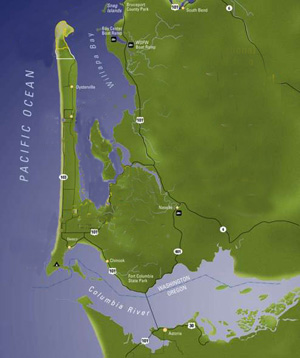
Willapa Bay is the vertical body of water protected from the
Pacific by the Long Beach peninsula. The large river streaming
into the Pacific is the Columbia River, which divides Washington and Oregon, its neighbor to the south, and is famed for salmon
fishing.
|
Oyster Varieties
The oysters arrive live, in a cooler with gel ice. Many oyster recipes start by telling you to scrub the oysters clean with a brush. Ours look like they have already been scrubbed. There is no grit: these beauties are clean through-and-through. Note that the photos below are not representative of the relative sizes of the species. Although they seem to go from small to large, the reverse is true: The top photo, the Pacifics, are the largest oysters; the Virginicas medium-size; and the bottom photo, the Kumamotos, are the smallest.
- Pacific Oysters. Pacific oysters (Crassostrea gigas) are available in Extra Small (2 to 3-1/2 inches in shell length) and Small (3 to 4 inches); but in our opinion, the reason to buy whole Pacifics is the
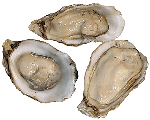 larger sizes, yielding big pieces of oyster meat. For us, the most frustrating thing as an oyster lover is there’s so little meat on the half shell of so many varieties. That’s why people can go through two dozen and still want more. If there were a single half-pound or pound-size oyster, we’d just sit down with a knife and fork and enjoy it like a steak. The Large and Extra Large Jumbo Pacifics get one closer to that fantasy: the Large are 4 to 5-1/2 inches and Extra Large Jumbo Oysters are a whopping 6 inches or more. They are firm, meaty and very slightly briny, with pleasant vegetal undertones from that hearty buffet of plankton. larger sizes, yielding big pieces of oyster meat. For us, the most frustrating thing as an oyster lover is there’s so little meat on the half shell of so many varieties. That’s why people can go through two dozen and still want more. If there were a single half-pound or pound-size oyster, we’d just sit down with a knife and fork and enjoy it like a steak. The Large and Extra Large Jumbo Pacifics get one closer to that fantasy: the Large are 4 to 5-1/2 inches and Extra Large Jumbo Oysters are a whopping 6 inches or more. They are firm, meaty and very slightly briny, with pleasant vegetal undertones from that hearty buffet of plankton.
- Virginica Oysters. The Virginica (Crassostrea virginica) is the proper name for what is called
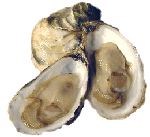 the East Coast oyster, the Atlantic oyster and many other names depending on the location where it is harvested (Blue Points and Malpeques are just two examples—see the yellow box below). A mollusk that fed the Colonists and has delighted generations of Americans, it was once plentiful along the entire coastline. It has succumbed to pollution in many of its native locations, but it is a happy transplant to Willapa Bay, where it grows from 2-1/4 to 3-1/4 inches in length. Its sculptured, deep cup is filled with a slightly briny liquor. The light-colored meat is firm and crisp; the flavor is delicate, light and smooth. the East Coast oyster, the Atlantic oyster and many other names depending on the location where it is harvested (Blue Points and Malpeques are just two examples—see the yellow box below). A mollusk that fed the Colonists and has delighted generations of Americans, it was once plentiful along the entire coastline. It has succumbed to pollution in many of its native locations, but it is a happy transplant to Willapa Bay, where it grows from 2-1/4 to 3-1/4 inches in length. Its sculptured, deep cup is filled with a slightly briny liquor. The light-colored meat is firm and crisp; the flavor is delicate, light and smooth.
- Kumamoto Oysters. Kumamoto oysters (Crassostrea sikamea)
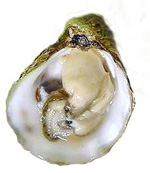 are the smallest of oysters eaten on the half shell, at just 1-3/4 to 2-1/4 inches. Like most oysters, which are named for their geography, they originated in Kumamoto Bay off Kyushu, the southernmost island of Japan. The Kumamoto has a highly sculptured, fluted upper shell and a very deep cup, with a generous amount of meat for its small size. The cup holds a good amount of delicious liquor. The distinctly colored meat is firm and crisp and the flavor is fruity and slightly briny, making kumamotos a half shell-lover’s favorite. (This is despite the need to eat many of them, unless one is blessed with “less is more” philosophy.) are the smallest of oysters eaten on the half shell, at just 1-3/4 to 2-1/4 inches. Like most oysters, which are named for their geography, they originated in Kumamoto Bay off Kyushu, the southernmost island of Japan. The Kumamoto has a highly sculptured, fluted upper shell and a very deep cup, with a generous amount of meat for its small size. The cup holds a good amount of delicious liquor. The distinctly colored meat is firm and crisp and the flavor is fruity and slightly briny, making kumamotos a half shell-lover’s favorite. (This is despite the need to eat many of them, unless one is blessed with “less is more” philosophy.)
- Shucked Oysters. If you don’t want them on the half shell, or more specifically, if you want oysters for stews, soups and other recipes, Willapa Oysters sells them shucked by the quart. They’re just as tasty and the professionals do all the work. In fact, if you want to eat the oysters raw and care more about the delicious meat than the effort of shucking for the beautiful presentation on the half shell, get the shucked oysters, put several meats and some liquor into a coquille shell—real or ceramic—pack crushed ice around it for atmosphere and enjoy them that way.
Different oyster varieties have flavors that range from bland to salty. Each of the Willapa oysters has a distinctive flavor. We find the Pacifics buttery and more flavorful, but acknowledge that having a big mouthful of meat contributes to the experience. The Virginicas are milder; the Kumamotos are brinier (saltier). It’s analogous to the difference between a strip steak, a sirloin and a porterhouse: each has its own nuances of texture and flavor and if you’re a steak lover you have your preference. But at the end of the day, you’d be glad to eat any of them.
Which do we prefer?
As an oyster lover, having dug into the big, meaty Large Pacifics, there’s no going back for us—only ahead, to the thrill of the Extra Large Jumbo Pacifics (they take much longer to grow and are quite a rarity—most get shipped to Japan). However, we recognize that not everybody wants a huge forkful of oyster meat: some people just want a little taste. For them, we would recommend the Small Pacifics, the Virginicas or the Kumamotos. Of course, the journey of discovery involves sampling them all to learn which you like best. It’s not a question of price—from the least expensive to the most, there’s only a two dollar per dozen difference (shocking to those of us who pay two dollars or more per oyster. Paradoxically, the smaller Virginicas and Kumamotos cost a dollar more than the Large Pacifics; but since the smaller oysters are much lighter, the shipping weight actually makes the total less expensive. However, with a nod to Louis Armstrong—“If you go for oysters and I go for ersters, I’ll order oysters and cancel the ersters”—nobody need be nickel-and-diming here or calling the whole thing off. Just enjoy.
How To Enjoy These Oysters
No 19th-century banquet would have been complete without a dozen or more of oysters for each guest. Multimillionaire railroad tycoon “Diamond Jim” Brady (James Buchanan Brady, 1856–1917) began dinner each evening with two or three dozen on the half shell. Today’s bon vivants continue to enjoy oysters—perhaps not as many or as often.
- Purists garnish oysters on the half shell with just a few drops of fresh lemon juice. For something new, you can try lime juice; or revert to something old, a Mignonette Sauce (1/2 cup of good red wine vinegar and 2 tablespoons of finely chopped shallots or sweet onion). As a sushi dévotée, we also mix up a “Japanese Mignonette” with light soy sauce (read our article on truly superior soy sauces), rice vinegar and a tiny dab of real wasabi.
- Because we photograph the food, we also made a red cocktail sauce that looks good in pictures—equal parts of Heinz chili sauce (never ketchup!), half prepared horseradish (never fresh-grated). In actuality, the classic cocktail sauce recipe works for shrimp but its heaviness masks the flavor of delicate oyster meat (however, it is a solution for sub-par, i.e. tasteless, oysters).
- We actually needed none of these, not even a drop of lemon juice. The oysters were so exquisite, so perfect, that we became more pure than the purists, eschewing anything but a fork.
So, we said to ourselves, munching as happily on our oysters as they had munched on their plankton...this is what fresh oysters taste like, taken from pristine beds. They tasted heavenly, and the Large Pacific in the photo at the left is HALF its actual size.
We opted for the less expensive 2-Day FedEx. In fact, the oysters were still lovely on Day 4 (don’t shuck them until you’re ready to eat them), although not quite as perfect as on Day 2 when they arrived. Willapa Oysters recommends that they be eaten within two days of arrival (i.e., Day 4 assuming a 2-Day FedEx shipment). By Day 5 they had become “restaurant oysters”—the magic was gone.
|
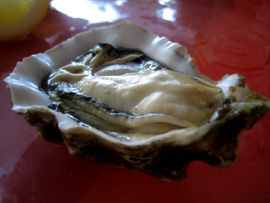
A plump Pacific oyster, 4-1/2 inches long. Photo by
Melody Lan.
|
On the website, John Rowell states that these fresh-shucked oysters will make the best fried oysters, oyster stew and grilled oysters we have ever tasted. Of that we have no doubt. But he has lived his life amid a daily wealth of the cleanest, fresh-picked oysters and we are too new to the joy of them. Fry them? Grill them? You might as well ask us to fry what’s left of the beluga.
For the next few shipments, at least, we’ll be enjoying each beautiful oyster neat. But if you’d like them cooked, it’s quite easy to make simple preparations. There are plenty of Rowell’s favorite, easy-to-make recipes on the Willapa Oysters website (in fact, he matches oyster types to recipes), as well as helpful techniques. Who knew oysters could be opened in the microwave—not cooked, just opened! We shucked ours: there are step-by-step instructions with photos on the website. Oysters can be cooked in the shell: the heat kills the oysters and they open by themselves.
When should you have oysters?
- For brunch (think of Eggs Benedict with oysters instead of the ham)
- As a first course at lunch or dinner
- With cocktails
- As a low-calorie, high-protein snack
- For parties and special dinners
- As an innovative gift idea (send the oysters along with a shucking knife and glove, available from Willapa Oysters)
Father’s Day is coming, as are summer barbecues.
From left to right: Pacific, Virginica and Kumamoto oysters.
|
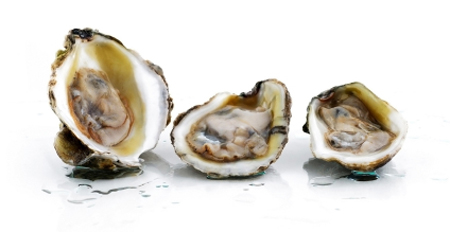 |
Health Benefits Of Oysters
Oysters are not only delicious, but they’re also one of the most nutritionally well-balanced foods. They’re high in protein, low in fat and loaded with essential minerals.
- Ounce for ounce, oysters have fewer calories and about the same level of cholesterol as white-fleshed fish; and are much lower in fat, cholesterol and calories when compared to poultry.
- The National Heart and Lung Institute suggests oysters as an ideal food for inclusion in low-cholesterol diets.
- Oysters are an excellent source of vitamins A, B1 (thiamin) B2 (riboflavin), B3 (niacin), C (ascorbic acid) and D (calciferol). Four or five medium-size oysters supply the recommended daily allowance of calcium, copper, iodine, iron, magnesium, manganese, phosphorus and zinc.
- One entire cup of oyster meat (that’s as much as Diamond Jim Brady would consume) is just 160 calories. Figure 10 calories per medium oyster, or 20 calories per ounce of oyster meat.
Whether you enjoy them raw or cooked, you can enjoy them in abundance.
Oyster Party: Call Your Friends
John Rowell says that his oysters are the freshest and finest available anywhere. We haven’t had every oyster everywhere, but we can’t imagine any better. When you look at the price of the oysters—$11.25 to $12.75 per dozen of the best—if you purchase several dozen to amortize the shipping, you can eat yourself into an oyster frenzy. In fact, get your oyster-loving friends together, order two or three dozen per person and have a feast, just like Diamond Jim. You can hire someone to do the shucking. Have everyone bring a bottle of Champagne or Chablis (the perfect wine for oysters), with sparkling water for the designated drivers, and you’ll have a party that will live in memory...until you’re compelled to make it a regular event.
—Karen Hochman
FORWARD THIS NIBBLE to anyone who loves oysters, needs to give a special gift, or is planning ahead for Father’s Day, for Memorial Day and for Independence Day festivities.
WILLAPA OYSTERS
Kumamoto, Pacific and Virginica Oysters
Purchase online at Willapa-Oysters.com.
Phone 1.360.665.2525
Fax 1.360.665.5116
E-mail
Info@Willapa-Oysters.com
|
 |
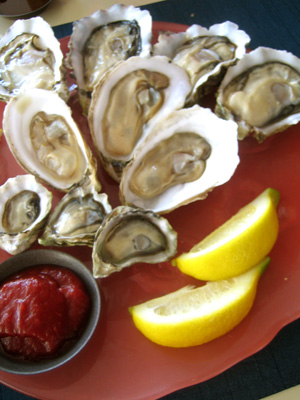
Top row: Pacific oysters. Middle row: Virginica oysters.
Bottom row: Kumamoto oysters. Photo by Melody Lan.
|
Read about some of our other
favorites in these sections of
THE NIBBLE:
|
|
For Your Oysters
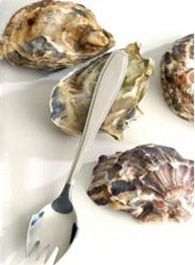 |
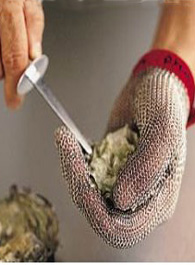 |
| Oyster Forks. Unique delicacies call for unique tools, and the Endurance Oyster Fork Set provides the perfect instruments for oysters. Shortened prongs and wide bowls grab and hold, allowing for graceful removal of oyster meat from the shell. This dishwasher-safe set is made from highly polished 18/10 stainless steel. Set of 4. Dimensions: 6 inch overall. Click here for more information. |
Oyster Glove. This French luxury kitchen accessory looks like chain mail and is indeed your protector against the knife when opening oysters, clams, or undertaking other tasks that require protection— boning or filleting meat or fish, or even slicing bagels. Knit with tiny, interlocking metal links and fitting either hand, this glove is the crème de la crème—you can buy a protective rubber mitt for $10.00. But it is the Ferrari of the genre. Click here for more information. |
FOR ADDITIONAL INFORMATION, special offers,
contests, opinion surveys, THE NIBBLE
back issues archive, product gift-finder, links to our favorite
food websites, and the ability to nominate YOUR favorite nibbles,
visit the home page of TheNibble.com.
Do you have friends who would enjoy THE NIBBLE?
Click here to send them an invitation to sign up for their own copy. |
ABOUT THE NIBBLE. THE NIBBLE™, Great Food Finds™, is an online magazine plus newsletters about specialty foods and the gourmet life. It is the only consumer publication and website that focuses on reviewing the best specialty foods and beverages, in every category. The magazine also covers tabletop items, gourmet housewares, and other areas of interest to people who love fine food.
© Copyright 2004-2026 Lifestyle Direct, Inc. All rights
reserved. All information contained herein is subject to change at any time
without notice. All details must be directly confirmed with manufacturers, service
establishments and other third parties. The material in this newsletter may not
be reproduced, distributed, transmitted, cached, or otherwise used, except with
the prior written permission of Lifestyle Direct, Inc.
|
 |
|
 |







 revelation: we ended our initial experience knowing that we had never had anything as good as the pristine, absolutely fresh oysters that arrived at our doorstep, picked from beds in Willapa Bay, Washington. Even as a fervent foodie, if it weren’t for our job—which is to discover fabulous foods—we’re not sure we would have ordered oysters by mail. We live in a seaport and there’s a great fish market five blocks away.
revelation: we ended our initial experience knowing that we had never had anything as good as the pristine, absolutely fresh oysters that arrived at our doorstep, picked from beds in Willapa Bay, Washington. Even as a fervent foodie, if it weren’t for our job—which is to discover fabulous foods—we’re not sure we would have ordered oysters by mail. We live in a seaport and there’s a great fish market five blocks away. 
 larger sizes, yielding big pieces of oyster meat. For us, the most frustrating thing as an oyster lover is there’s so little meat on the half shell of so many varieties. That’s why people can go through two dozen and still want more. If there were a single half-pound or pound-size oyster, we’d just sit down with a knife and fork and enjoy it like a steak. The Large and Extra Large Jumbo Pacifics get one closer to that fantasy: the Large are 4 to 5-1/2 inches and Extra Large Jumbo Oysters are a whopping 6 inches or more. They are firm, meaty and very slightly briny, with pleasant vegetal undertones from that hearty buffet of plankton.
larger sizes, yielding big pieces of oyster meat. For us, the most frustrating thing as an oyster lover is there’s so little meat on the half shell of so many varieties. That’s why people can go through two dozen and still want more. If there were a single half-pound or pound-size oyster, we’d just sit down with a knife and fork and enjoy it like a steak. The Large and Extra Large Jumbo Pacifics get one closer to that fantasy: the Large are 4 to 5-1/2 inches and Extra Large Jumbo Oysters are a whopping 6 inches or more. They are firm, meaty and very slightly briny, with pleasant vegetal undertones from that hearty buffet of plankton. the East Coast oyster, the Atlantic oyster and many other names depending on the location where it is harvested (Blue Points and Malpeques are just two examples—see the yellow box
the East Coast oyster, the Atlantic oyster and many other names depending on the location where it is harvested (Blue Points and Malpeques are just two examples—see the yellow box  are the smallest of oysters eaten on the half shell, at just 1-3/4 to 2-1/4 inches. Like most oysters, which are named for their geography, they originated in Kumamoto Bay off Kyushu, the southernmost island of Japan. The Kumamoto has a highly sculptured, fluted upper shell and a very deep cup, with a generous amount of meat for its small size. The cup holds a good amount of delicious liquor. The distinctly colored meat is firm and crisp and the flavor is fruity and slightly briny, making kumamotos a half shell-lover’s favorite. (This is despite the need to eat many of them, unless one is blessed with “less is more” philosophy.)
are the smallest of oysters eaten on the half shell, at just 1-3/4 to 2-1/4 inches. Like most oysters, which are named for their geography, they originated in Kumamoto Bay off Kyushu, the southernmost island of Japan. The Kumamoto has a highly sculptured, fluted upper shell and a very deep cup, with a generous amount of meat for its small size. The cup holds a good amount of delicious liquor. The distinctly colored meat is firm and crisp and the flavor is fruity and slightly briny, making kumamotos a half shell-lover’s favorite. (This is despite the need to eat many of them, unless one is blessed with “less is more” philosophy.)



